Medieval History
My apologies for neglecting the blog, it has been rather a hectic ten days. My day off last week, which is the day I usually write for the blog was taken up with a visit to Nottinghamshire with Gordon Plumb. We went to a couple of very fine churches. One of these was in the hamlet of Fledborough, which sits in the Trent flood plain. We went there ostensibly to see the remarkable collection of medieval stained glass that the church contains. More of that in later posts.
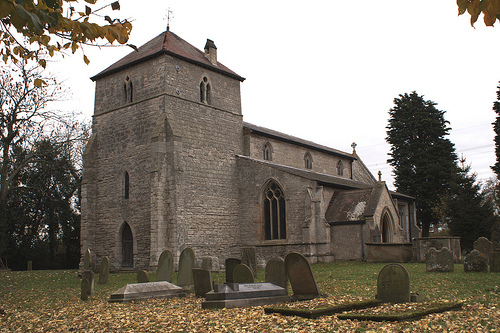
Among the other interesting features that caught my eye in this building, are a number of elements that hint at the medieval liturgical arrangements of this church.
In the chancel are two interesting panels of sculpture built into the north chancel wall. The first of these is rather badly preserved, but it is fairly clear that it portrays Our Lord rising from the tomb, flanked by figures of angels swinging censers. In between the angels are wo floriated finials, so it would seem that this panel formed the top of composition including a couple of arched canopies.

The second, better preserved panel, shows three knights, each set under and crocketed ogee arch. There are apparently fast asleep, one rests his head on his hands, another props himself up on his sword.
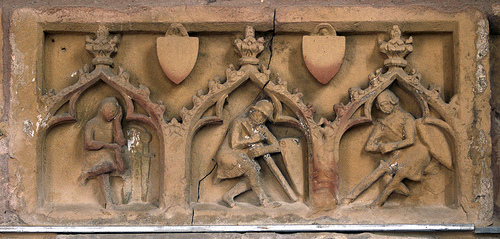
These two panels probably formed part of the Easter Sepulchre, a piece of furniture which was used during the paschal Triduum in the English medieval liturgies. During high mass on Maundy Thursday two hosts were consecrated and one of these, along with a crucifix, were placed in the sepulchre, to simulate the burial of Christ. A watch was set on the sepulchre until Easter morning, when the host and crucifix were removed.
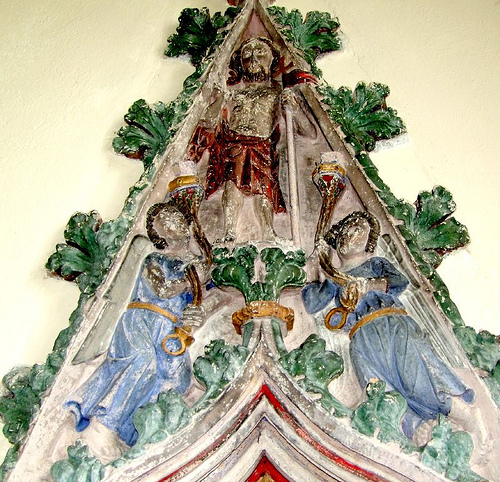
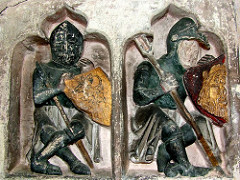
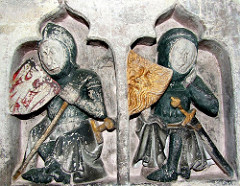
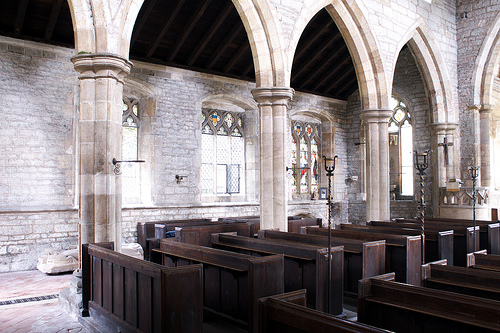
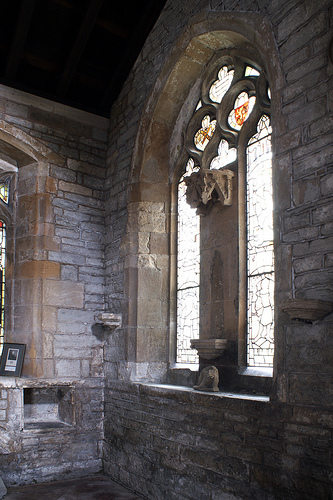
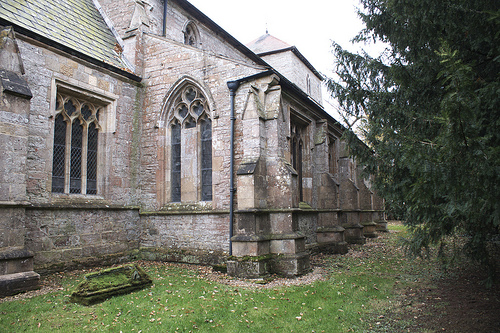
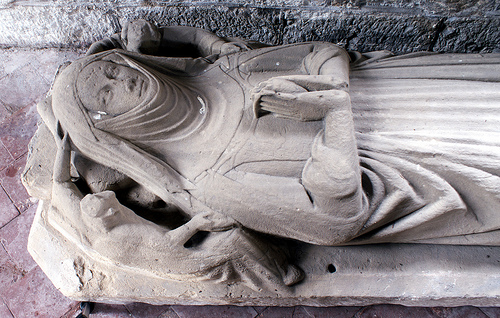
- Sanctuary Fittings And Something Rare
As well as the original pavement the chancel of Laxton church in Nottingham is lucky enough to still retain its stone sanctuary furnishings, fourteenth century piscina with double drains, Easter sepulchre, sedilia and image corbels. ...
- More Empty Niches!
A little more evidence of late medieval devotion for you. This glorious Perpendicular tabernacle is in the east wall of the late fifteenth century north aisle of St Bartholomew's Aldsworth in Gloucestershire. No prizes for guessing whose image it...
- Reconstructing A Lost Window - Annesley, Nottinghamshire
The once glorious church of All Saints in Annesley, Nottinghamshire is now a rather dilapidated ruin. The church ended in such a sorry way as a consequence of the industrial revolution. From the 1850s onwards the population of Annesley migrated to...
- Holy Cross Day Part Ii - The Exaltation Of The Cross
Morley, Derbyshire, originally uploaded by Vitrearum.I have been reminded that in medieval calendars the Invention of the Holy Cross, the discovery of the True Cross by St Helena, was commemorated in May the 4th. It is only in the modern calendars of...
- Invention Of The Holy Cross
Norbury, Derbyshire, originally uploaded by Vitrearum.This figure of St Helen holding the True Cross is an appropriate image for today as we celebrate the feast of the Holy Cross, or to give it its western title Exaltatio Sanctae Crucis, the 'Raising...
Medieval History
Shadows of former things
My apologies for neglecting the blog, it has been rather a hectic ten days. My day off last week, which is the day I usually write for the blog was taken up with a visit to Nottinghamshire with Gordon Plumb. We went to a couple of very fine churches. One of these was in the hamlet of Fledborough, which sits in the Trent flood plain. We went there ostensibly to see the remarkable collection of medieval stained glass that the church contains. More of that in later posts.

Among the other interesting features that caught my eye in this building, are a number of elements that hint at the medieval liturgical arrangements of this church.
In the chancel are two interesting panels of sculpture built into the north chancel wall. The first of these is rather badly preserved, but it is fairly clear that it portrays Our Lord rising from the tomb, flanked by figures of angels swinging censers. In between the angels are wo floriated finials, so it would seem that this panel formed the top of composition including a couple of arched canopies.

The second, better preserved panel, shows three knights, each set under and crocketed ogee arch. There are apparently fast asleep, one rests his head on his hands, another props himself up on his sword.

These two panels probably formed part of the Easter Sepulchre, a piece of furniture which was used during the paschal Triduum in the English medieval liturgies. During high mass on Maundy Thursday two hosts were consecrated and one of these, along with a crucifix, were placed in the sepulchre, to simulate the burial of Christ. A watch was set on the sepulchre until Easter morning, when the host and crucifix were removed.
Quite a number of sculptured Easter Sepulchre's survive in Nottinghamshire and in Lincolnshire. They are fairly standard in form. The well-preserved sepulchre at Heckington in Lincolnshire is a good example. The bottom of the sepulchre was a sort of tomb chest, representing the tomb of Christ. The figures of the sleeping soldiers, representing the watch placed on the tomb oif Jesus, were placed against this chest. Above that was a superstructure, incorporating a niche in which the host and crucifix were placed. Above that was an elaborate canopy and within this was incorporated an image of the risen Christ.
A slightly different version of the sepulchre remains at Sibthorpe in Nottinghamshire, but the iconography is the same, figures of soldiers along the base and the risen Christ in the canopy.



So what we have at Fledborough is the front panel of the tomb chest and the top panel of the canopy. The rest of the sepulchre has gone.
In the north aisle at Fledborough, which dates from the second quarter of the fourteenth century, are the remains of the liturgical arrangements of a side altar.


The side altar was evidently placed against the east wall of the aisle. The centre light of the window behind is blocked to admit a tabernacle that formerly contained a devotional image. The image was supported on a bracket and sheltered by a rather lovely canopy. The blocked centre light appears to have been part of the original design of the window. The shadow of the image that formerly stood here, appears against the back of this tabernacle, and it was clearly a standing figure. On either side of the window are two more brackets for devotional images. The sill of the window is fairly low, so the window, its glass and the devotional images around and above it would have formed a very effective reredos.

This chapel appears to have been a mortuary chapel, in the north wall is a burial niche with cross slab. Further down the aisle are a couple of medieval effigies, including this very striking early fourteenth century effigy of a woman. She holds her heart in her praying hands.

- Sanctuary Fittings And Something Rare
As well as the original pavement the chancel of Laxton church in Nottingham is lucky enough to still retain its stone sanctuary furnishings, fourteenth century piscina with double drains, Easter sepulchre, sedilia and image corbels. ...
- More Empty Niches!
A little more evidence of late medieval devotion for you. This glorious Perpendicular tabernacle is in the east wall of the late fifteenth century north aisle of St Bartholomew's Aldsworth in Gloucestershire. No prizes for guessing whose image it...
- Reconstructing A Lost Window - Annesley, Nottinghamshire
The once glorious church of All Saints in Annesley, Nottinghamshire is now a rather dilapidated ruin. The church ended in such a sorry way as a consequence of the industrial revolution. From the 1850s onwards the population of Annesley migrated to...
- Holy Cross Day Part Ii - The Exaltation Of The Cross
Morley, Derbyshire, originally uploaded by Vitrearum.I have been reminded that in medieval calendars the Invention of the Holy Cross, the discovery of the True Cross by St Helena, was commemorated in May the 4th. It is only in the modern calendars of...
- Invention Of The Holy Cross
Norbury, Derbyshire, originally uploaded by Vitrearum.This figure of St Helen holding the True Cross is an appropriate image for today as we celebrate the feast of the Holy Cross, or to give it its western title Exaltatio Sanctae Crucis, the 'Raising...
